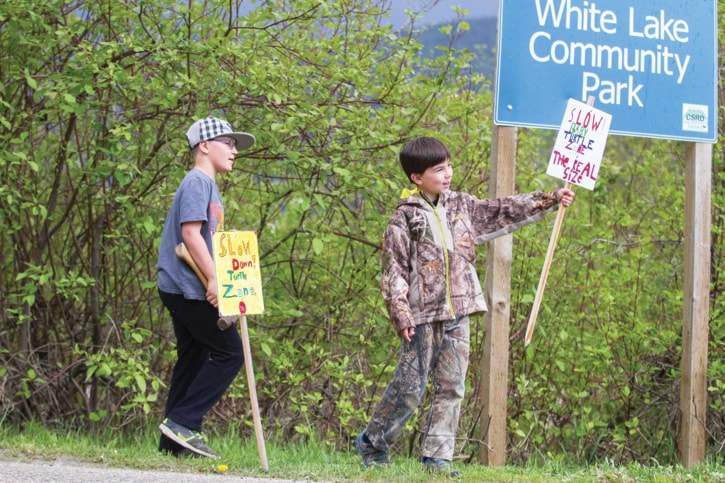Dedicated Carlin Elementary School students are making an effort to help save wildlife in the White Lake area.
Turtles, both babies and adults, are no match for vehicles as they try to navigate their way in both directions across Parri Road.
White Lake Stewards member Trish Wallensteen says last year 58 dead turtles were collected and 74 live turtles got a helping hand to cross the road.
“The numbers of hatchling turtles so far this year, starting from April 21 to 30th, is 25 dead and 16 live that were moved across the road,” she said last week. “Of course we hope there are more making it to the lake that we have not observed.”
While the turtles cross the road all along the lake, the two most popular crossings are near White Lake Community Hall and boat launch, and the John Evdokimoff Bike Skills Park.
Turtle eggs are laid from May to July and baby turtles hatch in September, remaining underground until the following spring.
As the temperatures warm up from mid April through May, the toonie-size baby turtles begin to move slowly across the road in their quest to reach the lake.
“Then they have their biggest hazard. After surviving freezing temperatures and prey in the form of ravens and crows, which dig up the eggs, and skunks, raccoons and otters, who eat the larger turtles,” Wallensteen says, noting that a turtle’s life is difficult enough without the added challenge of vehicular traffic.
While they can’t do a lot about the turtles’ animal predators, the Grade 4 students have created six colourful Coroplast signs to advise drivers to be on the alert for them.
“It seems to be so weather dependent; they don’t like to come out in the rain,” she says, pointing out the older females head back across the road to the lake after they have laid their eggs.
“In the evenings, we see the big ones swimming, usually close to after sundown.”
Another partner in the turtle protection caper is the Columbia Shuswap Regional District (CSRD) who created a sandy turtle habitat and put out their own turtle-crossing signs.
Last year, Carlin’s Grade 4-5 students painted a mural on the cement barrier the regional district installed at the edge of the hatchery. And for their efforts, White Lake Stewards are partnering with B.C. Parks.
“We’re a small group of organizers, but kind of a loose affiliation of people who are out walking and biking and care about the turtles,” laughs Wallensteen. noting efforts are beginning to pay off.
“We have quite a few paranoid drivers out here stopping for gravel.”
White Lake Stewards’ care for their surroundings and its inhabitants extends far beyond turtles.
On June 5, volunteers will again be on the lake to try to get rid of the invasive and highly stubborn flag iris.
Wallensteen is excited that a Thompson Rivers University student will attend with some kind of boxes that will be placed over the plants’ rhizomes to kill them and prevent their spread. Allowed to thrive unchecked, flag iris will flourish and choke out other vegetation.
